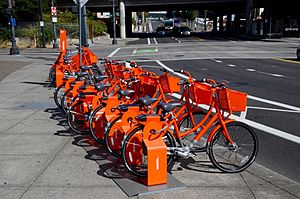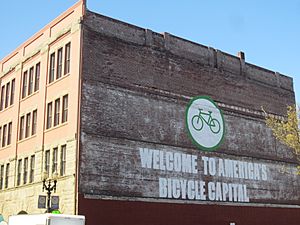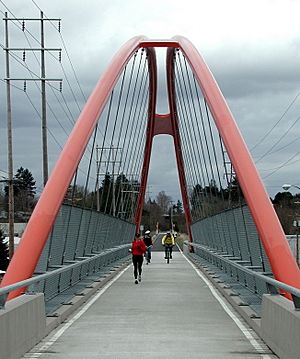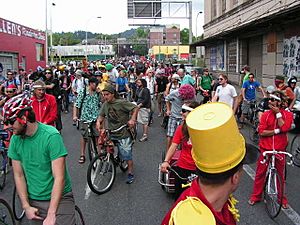Cycling in Portland, Oregon facts for kids
More and more people in Portland, Oregon are choosing to ride bikes! Since 2001, the number of bike riders has almost tripled. For example, the number of bikes crossing four main bridges over the Willamette River grew from about 2,800 before 1992 to over 16,000 in 2008. This happened partly because the city made better places for bikes.
The Portland Bureau of Transportation says that about 6 out of every 100 people who work in Portland bike to work. This is the highest number in any big U.S. city, and it's about 10 times more than the average for the whole country!
Because of its great efforts to make biking easy and safe, Portland has won many awards. It even got the highest award, 'platinum status,' from the League of American Bicyclists. In 2019, it was ranked the second most bicycle-friendly city in the U.S. by CNBC.
In July 2016, Portland started its own bike-sharing program called "Biketown". It got this name because of a deal with Nike. The program started with 1,000 bikes and 100 stations. A company called Motivate runs it. In its first two months, people rode Biketown bikes more than 100,000 times!
Contents
How Portland Became Bike-Friendly
The Yellow Bike Project
In 1994, local activists Tom O'Keefe and Joe Keating started a fun project called The Yellow Bike Project. They wanted to make Portland even more bike-friendly. They got bikes donated and had young people from the Community Cycling Center fix them. Then, they painted the bikes bright yellow and put them around Portland for anyone to use for free!
O'Keefe got the idea from a similar project in Amsterdam. The project had a funny slogan, "Gratis Pedalis Feralvus," which meant "Free Wild Pedals." About a dozen yellow bikes were launched at first, painted for free by a local auto body shop. Eventually, 60 to 100 bikes were part of the project. Sadly, the project ended because bikes were stolen, damaged, or thrown into the Willamette River.
Bicycle Transportation Alliance (BTA)
The big change for bikes in Portland really started with the creation of the Bicycle Transportation Alliance (BTA) in November 1990. The BTA's first goal was to convince TriMet, the local public transportation company, to let people bring their bikes on buses and light rail trains.
The BTA collected over 7,000 signatures and got support from many local city councils. This led TriMet to try out the idea for one year on a few bus lines. After a year, there were no big problems, and more cyclists started using public transport. Because of this, TriMet became the first major transit system in the U.S. to allow bikes on all its buses and trains.
The Bicycle Transportation Alliance grew into one of the most successful groups in the U.S. that works for cyclists. The BTA focused on making major streets safe for biking. They pushed for bike lanes, improvements to all seven bridges over the Willamette River that connect downtown to the rest of the city, and safe places to park bikes.
In 1992, the BTA successfully sued the City of Portland. They used an Oregon law called the "Bicycle Bill" (ORS 366.514). This lawsuit made the City provide bike facilities as part of all its projects. The City tried to fight this in court, but the Oregon Court of Appeals agreed with the BTA. This decision made it clear that all governments in Oregon must provide safe places for bikes and walkers in all their projects.
Portland's Bike Plans
Portland started planning for city transportation in the early 1970s. This was after the state of Oregon passed important laws about how land is used. Portland then created its first 'Bicycle Master Plan' in 1973.
1973 Bike Plan
The city's first bike plan was adopted in 1973. It was called the '1973 Portland Bike Plan'. This plan aimed to build almost 190 miles of bike paths and lanes in the city. It also created a Bicycle Advisory Committee made up of citizens and a Bicycle Program within the city’s Transportation Bureau.
1996 Bike Plan
By 1996, the city had built almost all the 190 miles of bike paths from the first plan. So, the city adopted its second bike plan in 1996, called the 'Portland Bicycle Master Plan'. This plan aimed to build an extra 445 miles of bike paths over the next 20 years. This would bring the total to 630 miles by 2016.
2010 Bike Plan
The city updated its bike plan again in February 2010. The Portland City Council voted to approve its third bike plan, called the 'Portland Bicycle Plan for 2030'. This plan set aside $613 million to be spent on bike paths and lanes over the next 20 years. It aimed to increase the total bike paths from 630 miles by 2016 to 962 miles by 2030. It also wanted to increase the number of people who bike daily (called "modal share") from 7-8% to 25% by 2030. By the end of 2009, only about 300 miles of bike paths had been built. So, the plan aimed to build 662 miles of new bike paths in the city over the next 20 years.
2012 Speed Limit Changes
In 2012, Portland lowered speed limits on about 70 miles of special neighborhood streets. The speed limit went from 25 miles per hour to 20 miles per hour. This was done to make these streets safer for the growing number of walkers and bikers using them.
Bike Paths and Features
Portland is building a network of bicycle boulevards to make cycling easier and safer. These are streets that are designed to be friendly for bikes. East Portland is especially good for this because its streets are laid out in a consistent grid. These boulevards have special street markings, signs, and better signals at busy intersections to help cyclists.
Another popular route is the Vera Katz Eastbank Esplanade.
To help prevent crashes between cars and bikes, the city has painted parts of dangerous bike lanes blue.
More recently, the city has put in special "bike boxes" at intersections. These are painted areas that let bicyclists wait ahead of cars at red lights. This makes them more visible and safer when the light turns green.
A big step for everyday biking in Portland was when the sidewalks of the Hawthorne Bridge were made wider in 1997. This made it much safer and easier for people to bike across the Willamette River to get to work or school.
In 2004, a bike path along the Sunset Highway was finished. This path helps connect Beaverton and downtown Portland.
Bicycle access to the Morrison Bridge opened in March 2010, which was also a big step.
In recent years, Portland has built bridges just for walkers and cyclists. These bridges help people cross busy highways or the Willamette River safely. Some of these bridges include the Blumenauer Bridge (2022), Ned Flanders Crossing (2021), and the Tilikum Crossing (2015). The Tilikum Crossing is also open to MAX trains, buses, and the Streetcar, but not personal cars.
In 2021, the Portland Bureau of Transportation (PBOT) started putting large, concrete planters on neighborhood streets. These replaced traffic cones that had been used before. They are placed at intersections in neighborhoods to help slow down car traffic. Most of them have signs that suggest a speed limit of 15 miles per hour.
Bicycle Parking
A new project will add covered bicycle parking to the popular Southeast Hawthorne Boulevard shopping area. This will give cyclists a safe and dry place to leave their bikes.
Bike Events
The Bicycle Transportation Alliance (BTA) holds an annual Bike Commute Challenge. Thousands of people who bike to work compete for prizes and recognition based on how often and how far they ride.
Pedalpalooza is a yearly festival with hundreds of free bike events. These events are organized by the community and are a fun way to celebrate cycling in Portland.
Bike Riding Statistics
The table below shows how many people in Portland have biked to work over the years. This data comes from the Census Bureau's yearly American Community Survey. "Bike c. share" means the percentage of people who bike to work.
| Calendar year | 1990 | 2000 | 2005 | 2010 | 2014 |
|---|---|---|---|---|---|
| Portland bike c. share | 1.2% | 1.8% | 3.5% | 6.0% | 7.2% |
| National bike c. share | 0.4% | 0.4% | 0.4% | 0.5% | 0.6% |





